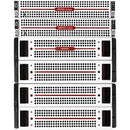Description
Veritas Access 3340 NAS Storage System is a software-defined, scale-out NAS platform engineered to elevate enterprise storage for unstructured data workloads. Designed to simplify management while delivering robust performance, the 3340 unifies file, object, and cloud-tiered storage within a single global namespace. By decoupling software from hardware, this solution provides flexible deployment, easier upgrades, and predictable costs—making it an ideal choice for media libraries, analytics datasets, large-scale file shares, and other demanding unstructured workloads. Its scale-out architecture preserves performance as you add nodes, enabling seamless growth from terabytes to petabytes without disruptive migrations or forklift upgrades. With centralized management and automation across the cluster, Veritas Access delivers policy-based provisioning, health monitoring, automated updates, and non-disruptive maintenance, so IT teams can focus on delivering data-driven insights rather than juggling infrastructure. Multi-protocol access with a global namespace ensures users and applications can access data via NFS, SMB, or object interfaces, empowering teams to work the way they prefer. And with advanced data protection, cloud readiness, and efficiency features, the 3340 helps organizations accelerate data-driven initiatives while reducing storage sprawl and maintaining governance across diverse workloads.
- Scale-out performance with effortless growth: Add nodes to expand capacity from terabytes to petabytes without disruptive migrations or forklift upgrades, preserving throughput and latency as your data footprint grows.
- Unified, multi-protocol access under a single namespace: NFS, SMB, and object interfaces share one global namespace for consistent data visibility, simplified policy enforcement, and streamlined application access.
- Centralized software-defined management: Web-based GUI, REST APIs, and CLI tools offer policy-based provisioning, health monitoring, automated updates, and non-disruptive maintenance across the entire cluster.
- Advanced data protection and efficiency: Integrated snapshots and replication, data integrity checks, encryption at rest and in transit, and compatibility with Veritas backup and disaster-recovery workflows—plus options for deduplication and compression to boost efficiency.
- Cloud-ready intelligence and tiering: Intelligent data tiering moves cold data to on-premises or cloud storage, enabling cost optimization while preserving fast access for hot data and simplifying long-term retention strategies.
Technical Details of Veritas Access 3340 NAS Storage System
- Form factor: Enterprise-scale NAS appliance designed for data-center deployments with scalable expansion capabilities.
- Processor and memory: Multi-core, x86-based controllers with ECC memory for reliability and consistent performance under load.
- Storage capacity and expansion: Scales from initial capacity to petabytes with modular expansion shelves and mixed drive types (HDD and SSD) to balance cost and speed.
- Network connectivity: Flexible networking options including 10/25/40 GbE Ethernet and optional Fibre Channel interfaces for diverse environments.
- Protocols and access: NFS (v3/v4), SMB (v2.1/v3), FTP/SFTP, and object storage interfaces with S3-compatible or equivalent APIs for cloud-ready workflows.
- Global namespace: A single, consistent namespace across all nodes that simplifies data access and policy application.
- High availability: Redundant controllers, power supplies, and robust failover to maximize uptime in mission-critical settings.
- Management and automation: Web-based GUI, REST APIs, and CLI tools for streamlined provisioning, monitoring, and lifecycle management.
- Security and governance: Role-based access control, encryption at rest and in transit, audit logs, and policy-driven data protection controls.
- Cloud integration: Tiering to cloud storage options to extend capacity and enable cost-effective long-term retention and disaster recovery.
How to Install Veritas Access 3340 NAS Storage System
- Plan and rack your hardware: Ensure power, cooling, and network infrastructure meet the system requirements. Verify the environment supports the number of expansion shelves and drive types included with your package. Confirm the anticipated growth path to petabytes and map out initial namespaces and access policies.
- Connect and power up: Install the 3340 appliance in a designated data center rack, connect redundant power supplies, and attach network interfaces (10/25/40 GbE and optional FC as needed). Power on and verify basic hardware health indicators before proceeding.
- Deploy the software-defined storage layer: Use the web-based management interface or CLI to initialize the cluster, configure controllers, and set up the initial global namespace. Establish cluster membership, interconnects, and security settings (RBAC and encryption in transit).
- Create storage pools and namespaces: Define storage pools with a mix of HDD and SSD drives to balance cost and performance. Create the global namespace, assign policy-based provisioning rules, and set up data protection parameters such as snapshots and replication schedules.
- Enable multi-protocol access and clients: Configure NFS, SMB, and object interfaces to align with your applications. Onboard clients and map shares to the appropriate namespaces, ensuring permissions and access controls align with governance requirements.
- Tune and monitor: Apply automated updates, verify health checks, and configure alerting. Validate data integrity and perform a non-disruptive test failover to confirm high availability and DR readiness.
Frequently Asked Questions
- What workloads is the Veritas Access 3340 best suited for? It is optimized for unstructured data workloads such as media libraries, analytics datasets, large-scale file shares, and other demanding environments that require scalable, multi-protocol access with strong data governance.
- How does the scale-out architecture benefit my organization? The architecture lets you add nodes incrementally to grow capacity and performance without downtime or disruptive migrations, preserving service levels as data volume increases.
- Which protocols are supported? NFS (v3/v4), SMB (v2.1/v3), FTP/SFTP, and object storage interfaces with S3-compatible APIs, enabling flexible access for diverse applications and teams.
- What security features are included? Encryption at rest and in transit, role-based access control, audit logs, and policy-driven data protection to meet governance and compliance requirements.
- Can I tier data to the cloud? Yes. The system supports intelligent cloud tiering to extend capacity, reduce on-premises costs, and simplify retention and disaster recovery workflows.
- How do I manage updates and maintenance? Centralized management supports automated updates and non-disruptive maintenance to keep the environment healthy with minimal operational impact.
Customer reviews
Showing - Of Reviews


